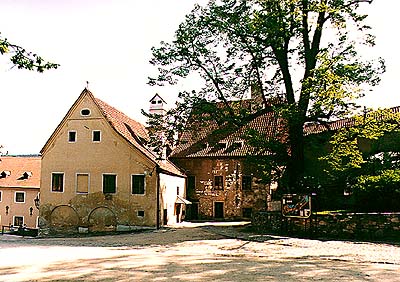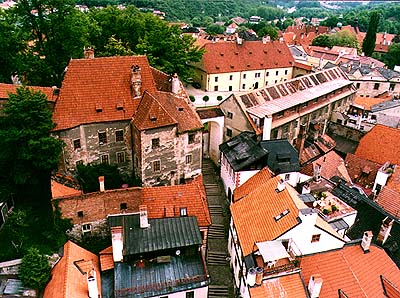Castle No. 58 - Old Burgrave´s House
Location :
A royal clerk\'s house known as the Burgrave\'s house, it is
located at the top of the hill of the Ist
Courtyard of Český Krumlov Castle, left of the castle
stairs.
Description :
The building is two-floored, partially sunk with a basement of
double depth. It is divided into two wings.
Historical building development :
The building has an irregular groundplan in which elements of
Gothic, Renaissance, and Baroque have been revealed. The ground
floor\'s Renaissance appearance has been preserved, mostly with the
vaults and the double-framed staircase. The first floor displays
evidence of newer reconstructions from the 19th and 20th centuries,
for example lower attics and a modified interior. A Renaissance
attic of Gothic type has been preserved above the eastern wing. On
the western side, the connecting
corridor leads through from the castle to the Minorite
monastery. The northing wings has a younger attic, being late
Baroque - early Classic. The Gothic and Renaissance cellars are
remarkably deep; they reach a depth of 620 cm below the ground
level.
Significant architectural details :
The most significant architectural element is an uncovered gothic
window at the upper basement behind the castle walls, which attests
to the gothic foundations of the building. Also here is the
aforementioned Renaissance staircase with criciform crest fields on
the ground floor, and landing with transverse barrel segment
vaulting on the first floor. On the first floor, and partly on the
ground floor, there seems to be preserved older and artistically
valuable truss construction.
History of residents :
The history of the house evidently reaches back to the 15th
century, but the first written evidence of the building comes to us
from 1600, when it was mentioned as a scribe\'s residence. In 1624
the building served the purposes of several people. The Burgrave
lived here together with the forest scribe and the scribe for
retirees and orphans. It was used as such until likely the 18th
century, when it became the residence for the Prince\'s Burgrave.
From the end of the 18th century the tax collector also lived
here.
Contemporary use :
Today the house is used for flats.
(ds)



